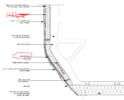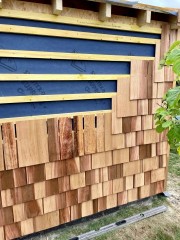- Joined
- 23 Nov 2023
- Messages
- 11
- Reaction score
- 0
- Country

The issue I am having with mould. I would appreciate folks' thoughts and help.
For context, we are based in the UK, and our construction system consists of; cedar shingles, cedar breather, felt underlayment, plywood, actis multi foil 90mm with an integrated vapor barrier followed by a plywood lining internal lining.
Essentially, we're having some mould marks internally now. I am unsure whether this is caused by mould due to humidity levels being as high as 80% in the cabin continually for the past 2-3 months or if it is due to poorly fitted roof shingles causing water to run in? Were going to install a de-humidifier etc as a starting point.
The issue is a roofer I spoke with today said we would need to rip the whole thing off and start again. Our shingle gauge is 150mm, but the roofer said this would need to be 125mm, which he believes is causing the issue. The roof has a pitch of 45° and 90°. Of course, we want to avoid this and would appreciate your thoughts.
I have attached some photos, including the interior, that show the mould.




For context, we are based in the UK, and our construction system consists of; cedar shingles, cedar breather, felt underlayment, plywood, actis multi foil 90mm with an integrated vapor barrier followed by a plywood lining internal lining.
Essentially, we're having some mould marks internally now. I am unsure whether this is caused by mould due to humidity levels being as high as 80% in the cabin continually for the past 2-3 months or if it is due to poorly fitted roof shingles causing water to run in? Were going to install a de-humidifier etc as a starting point.
The issue is a roofer I spoke with today said we would need to rip the whole thing off and start again. Our shingle gauge is 150mm, but the roofer said this would need to be 125mm, which he believes is causing the issue. The roof has a pitch of 45° and 90°. Of course, we want to avoid this and would appreciate your thoughts.
I have attached some photos, including the interior, that show the mould.



